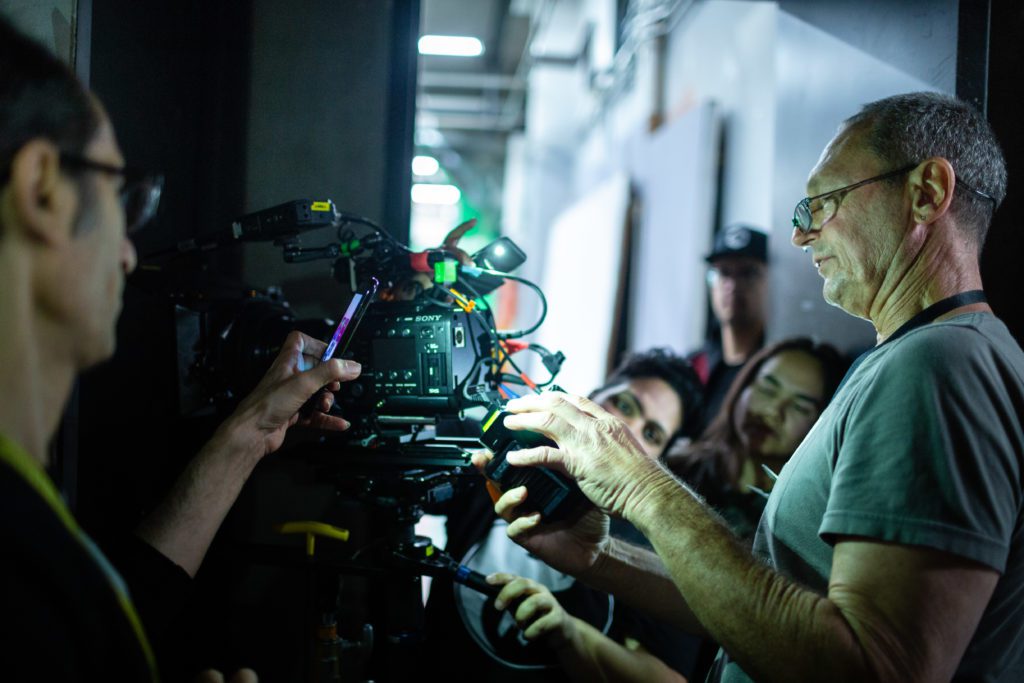Inside Look: Cinematography

What Does a Cinematographer Do?
When it comes to movies, visual storytelling is the most important part.
Why do people go to movies anyway? Essentially, we go to see and hear something beautiful. Without cinematographers, there is no movie. We sat down with film instructor Ed Rakochy to get an inside look at what cinematographers actually do and what it’s like to be the person behind the camera. Before we delve into the life of a cinematographer, we’d like to introduce you to our expert.
Meet Ed Rakochy, Film Instructor
Ed Rakochy is a film instructor here at The Los Angeles Film School. He primarily teaches Steadicam operation and cinematography for the film production program.
Ed worked for almost 30 years as a director of photography (DP) before teaching at The L.A. Film School. Ed spent ten of those years in broadcast TV on the East Coast before heading west to Los Angeles in 1988. As Ed says, commercials were his “bread and butter.” He worked for years as a director of photography on local TV productions, car commercials and broadcast news.
Cinematographers Guide the Mood
What is a cinematographer? Well, they’re “the camera guy,” according to Ed. But it’s about more than just camera movement. Cinematographers, also known as a director of photography or DP, are in charge of actually shooting the film and guiding the emotional tone of each scene.
The DP is “the first person visualizing what the audience is supposed to see.” They can offer suggestions to the director for what angle to take, close up or wide-angle shots, lighting, etc. They help determine the look and feel of the movie.
Three Essential Skills for a Director of Photography
As a DP, you must understand lighting, know your cameras and lenses, and help manage the entire crew on set.
Understanding of light. A DP is responsible for overseeing all the lighting with the gaffer. Ed says that light presents one of the greatest challenges to a cinematographer, but it’s also what makes or breaks a shot.
Know your cameras. Depending on what kind of shot your director wants, you’ll need to know which camera is appropriate and how to operate it. Ed says, “camera operating is a sport. It takes technique.”
Cooperation and collaboration. The cinematographer knows what the director wants because they strive to learn how the director thinks and operates. Then, they communicate those visions clearly to the cinematography crew. “Filmmaking is so collaborative,” Ed says. “It’s not just one genius. It’s many geniuses working together.”
Tips for an Aspiring Cinematographer
Whether it’s a commercial or the next Oscar-winning film, a DP needs to understand the director’s vision and work with them to achieve it. With that in mind, we asked Ed what three key shots are a must when making a successful film.
Killer master shot. This sets the tone of the entire sequence of shots. It’s not always the opening scene, but it will set the tone for everything else. Ed gave us two of his favorite examples:
The Copacabana shot in Goodfellas as they walk into the club through the kitchen with the waiters, the cooks, and the beautiful smoky atmosphere. A long Steadicam shot, it sets the feel for the whole movie.
Refinement of a closeup. Ed explains that “It’s all about the image you create in that box — how you refine it, where you place the light, the angle. Ed referenced the incredible close-up shots in Wonder Woman.
Moving shots. “It’s hard to light a moving shot,” Ed says. “It takes a lot of skill, and it takes a lot of thinking outside the box.” A recent example of incredible Steadicam work is from the Sam Mendes film, 1917. You follow one person continuously, and that difficult-to-achieve moving shot is so powerful.
How to Become a Cinematographer
When it comes to learning how to be an excellent director of photography, Ed’s first bit of advice is to practice as much as you can. “Get behind a camera and shoot and shoot and shoot and shoot as much as you can,” Ed says. “For lighting — get yourself in different environments and practice.”
He also remembers the impact of all the mentors he had along the way, helping him hone his skills and giving him a chance. “Mentorship is huge. Get on a set, and do what people tell you to do. Take the initiative to make things happen. Work hard. People will appreciate that,” Ed says.
Another cinematographer (also named Ed), wrote a piece on Medium about the 110 things he learned in 10 years working as a DP. Ed Moore’s article is helpful for anyone who wants bite-sized sentences filled with great advice.
There’s no better place to find mentors and practice your craft than right here at The Los Angeles Film School. Learn more about how our hands-on film tracks can help you develop your talents and create your future in the entertainment industry.
